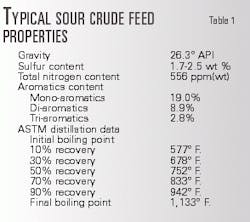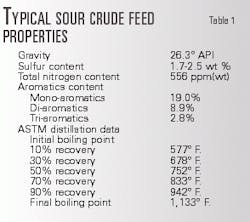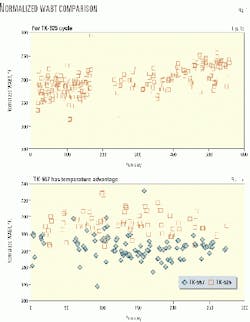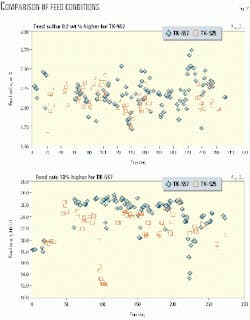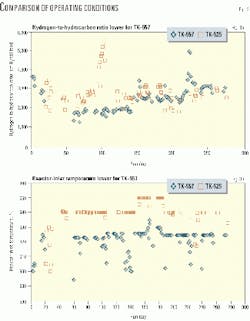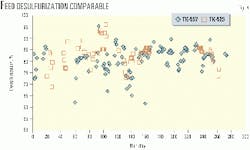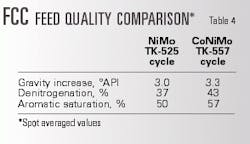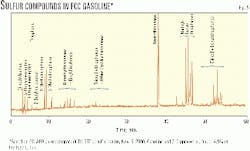New trimetallic catalyst improves FCCU feed quality
Although its previous hydroprocessing catalyst performed satisfactorily, a new trimetallic catalyst helped the Marathon Ashland LLC, Canton, Ohio, refinery achieve the same desulfurization with less severe operating parameters.
Even with a higher feed sulfur content, higher feed rates, and lower hydrogen-to-hydrocarbon ratios, the new catalyst improved overall fluid catalytic cracking unit (FCCU) feed quality. Furthermore, it accomplished these improvements with a 23° F. lower weighted average bed temperature (WABT).
The refinery demonstrated the performance of this new a cobalt-nickel-molybdenum (CoNiMo) based catalyst (TK-557), developed by Haldor Topsoe AS, in its fluid catalytic cracking (FCC) pretreat unit in the past year.
The previous cycle used nickel-molybdenum (NiMo) based catalyst TK-525, also a Topsoe catalyst.
New regulations call for refiners to reduce sulfur emissions from their regenerators and reduce sulfur contents of gasoline and diesel fuels. Hydroprocessing of intermediate-to-final products offers the refiner one viable alternative to meeting more stringent, environmental regulations.
New hydroprocessing catalysts must allow refining units to meet these future regulatory demands while optimizing refinery economics.
Pretreat unit function
Marathon Ashland's 70,000-b/d Canton refinery processes both sweet and sour crude in a blocked operation. The sweet crude has an average gravity of 37° API and a sulfur content of 0.5 wt %. The sour crude has an average 31° API gravity and a 1.8 wt % sulfur content.
This article only covers data collected during the sour crude runs.
The Canton refinery charges predominantly hydrotreated heavy vacuum gas oil (HVGO) to the FCCU. It also charges some untreated feed and purchased gas oils, as necessary, to meet processing objectives.
FCC feed pretreatment not only helps the refiner comply with stringent environmental regulations, but it also improves FCCU operations.
Since the FCCU is the major contributor of sulfur to the gasoline pool, it makes sense to increase the hydrotreating severity of the feed. Increased severity increases the refiner's reliance on the catalyst activity in the pretreater to meet sulfur regulations and improve yields from the FCCU.
Additionally, depending on conditions in the FCC pretreater, aromatic saturation of the feed, which converts polynuclear aromatics to mono-aromatic rings, helps improve FCCU yields.
Nitrogen removal from the feed helps increase the activity of the FCC catalyst circulating in the unit.
Nitrogen, particularly basic nitrogen, neutralizes the acid sites of zeolitics, which causes the site to lose its ability to promote cracking.
Canton's pretreat unit
Table 1 outlines the typical sour-crude run feed properties for the FCC feed pretreater for both the NiMo and CoNiMo catalyst cycles. Table 2 highlights some operating conditions used for the previous and current cycle.
The primary objective for this unit during both catalyst cycles was a minimum 80% desulfurization on the sour-crude run feed. A secondary objective was maximizing aromatic saturation and denitrogenation at the given desulfurization level.
Marathon Ashland specified a 2-year cycle length requirement for the NiMo catalyst and 3-year requirement for the CoNiMo catalyst.
NiMo catalyst cycle
The catalyst used in an FCC pretreater depends on the feed origin(s) and the objectives required by refinery economics or environmental concerns. The choice also depends on hydrogen availability. NiMo catalysts, for example, typically use more hydrogen than a comparable cobalt-molybdenum (CoMo) catalyst.
If desulfurization is the primary objective, a CoMo-based hydrotreating catalyst may be the best choice as the main bed catalyst. A NiMo-based hydrotreating catalyst, however, is usually the best choice if aromatic saturation and denitrogenation are the primary objectives.
With concern for refinery profitability and compliance with environmental regulations, refiners have used combination-bed arrangements in select applications. A combination-bed arrangement consists of a reactor fill in which a layer of NiMo catalyst is installed over a layer of CoMo catalyst.
This arrangement seeks to balance the desired activity objectives of desulfurization, denitrogenation, and aromatic saturation. This balance cannot be optimized for all feed quality improvements, however.
For example, if the product sulfur requirements are sufficiently low, the CoMo-based catalyst would dominate the arrangement, and the NiMo benefits would be marginal.
In March 1998, the Canton refinery installed Topsoe's NiMo TK-525 as the main bed catalyst in its FCC feed pretreater.
Topsoe developed TK-525 primarily for FCC feed pretreat applications with wide variations in feedstock qualities.
The refinery also installed Topsoe's grading system for pressure-drop control. Table 3 outlines the catalyst loading for this cycle.
This particular catalyst loading met the unit objectives for about 400 days until a problem with the vacuum unit occurred.
This upset caused the feed to the FCC pretreater to become heavier and more difficult to treat, which increased catalyst deactivation beyond the expected rate.
Despite running this more difficult feed, the unit predominately met its objectives. Once the refinery corrected the problems in the vacuum unit, the TK-525 activity stabilized.
With the problems encountered with the vacuum unit and the catalyst activity decline, Marathon Ashland decided to replace the catalyst at the next opportunity. Fig. 1a shows the normalized WABT for this cycle.
CoNiMo catalyst cycle
An alternative to the combination-bed arrangement is use of a trimetallic or CoNiMo-based catalyst.
Topsoe recently introduced CoNiMo-based hydrotreating catalyst, TK-557, for FCC feed pretreating.
Topsoe developed this trimetallic catalyst to take advantage of both catalyst types. In other words, TK-557 can offer the high desulfurization activity of a CoMo catalyst as well as the high denitrogenation and aromatic saturation activity of a NiMo catalyst.
To achieve maximum activity with TK-557, the vendor developed a specific catalyst carrier with an optimum cobalt-to-nickel-to-molybdenum ratio.
As part of the decision to replace the NiMo catalyst, Marathon Ashland wanted to maintain the same unit objective of 80% desulfurization, but with a 3-year instead of 2-year cycle.
The refiner also wanted to continue to improve its FCCU feed quality in terms of aromatic saturation and denitrogenation.
Based on Topsoe's development program for FCC feed pretreat catalyst and its pilot plant work, Marathon Ashland elected to load TK-557 as the main-bed catalyst for the next cycle to meet desulfurization, denitrogenation, and aromatic saturation objectives.
Table 3 outlines the loading for this cycle, done in January 2000. For this loading, Topsoe recommended installation of a layer of TK-525 above the TK-557 to condition the feed for any temporary excursions in feed quality.
Since TK-557 has not completed a full cycle, only data for the start-up through the end of 2000 is considered. Fig. 1b compares the normalized WABT for the TK-525 cycle with that of the TK-557 cycle.
Cycle comparisons
The following performance and operating comparisons are made on the first 300 days for each cycle, because the TK-557 cycle is still in progress.
Fig. 2a shows the sour crude's feed sulfur levels for comparative time periods between the two cycles.
The feed sulfur averaged 0.2 wt % higher for the TK-557 cycle, than the TK-525 cycle.
Fig. 2b shows the feed rates for the two cycles. The TK-557 cycle processed an average of 2,750 b/d, or 13%, more feed than the TK-525 cycle.
Fig. 3a compares the hydrogen-to-hydrocarbon ratio between the two cycles.
The ratio of the TK-557 cycle averaged 370 scf/bbl lower than that of the TK-525 cycle. Thus, the use of TK-557 required less hydrogen.
Fig. 3b presents the reactor-inlet temperature for the two cycles. The inlet temperature of the TK-557 cycle ran consistently 17° F. lower than that of the TK-525 cycle to meet product sulfur specifications.
Fig. 4 shows the desulfurization levels for the two cycles. Up to about run day 150, the desulfurization levels were mainly 75-80 % for the TK-557 cycle. After run day 150, the desulfurization level averaged 85%. With some temporary excursions, each cycle averaged at least the desired 80% desulfurization level.
Fig. 1b shows the WABT, normalized for feed and product sulfur, feed API gravity, feed rate, unit pressure, and recycle-gas rates. The data show that TK-557 has a relatively constant temperature advantage over TK-525.
FCC feed quality
Topsoe and Marathon Ashland determined feed-quality improvements in denitrogenation and aromatic saturation on a periodic basis.
Table 4 shows a summary of denitrogenation, aromatic saturation, and gravity based on average spot measurements at 80% desulfurization.
At the same desulfurization level, TK-557 improved denitrogenation and aromatic saturation activity by 7% with a considerably lower normalized WABT.
One interesting difference between the use of TK-557 and TK-525 is the color of the product from the FCC pretreater. Typically, the color of the feed to a FCC pretreater is medium to dark brown, and the product color is a shade lighter. In the Canton FCC pretreater, the typical feed color for the TK-557 cycle is dark brown, but the product color varies from near water white to light yellow.
FCCU gasoline quality
During the TK-557 cycle, Topsoe compared the impact of the CoNiMo catalyst vs. the NiMo catalyst on the type and amount of FCC gasoline sulfur.
Topsoe used a gas chromatograph equipped with an atomic emissions detector to analyze Canton's FCC gasoline from the TK-557 cycle.
It then compared the results to other gasolines derived from NiMo FCCU feed pretreatment, as well as to those without prior feed pretreatment.
Fig. 5 shows a chromatogram of the Canton FCC gasoline with the various sulfur types.
The chromatogram shows sulfur compounds in order of increasing retention times (boiling point): mercaptans, thiophene, C1 thiophenes, tetrahydrothiophene, C2 thiophenes, C3 thiophenes, C4 thiophenes, benzothiophene, C1 benzothiophenes, and C2 benzothiophenes.
Although total sulfur content varies from one gasoline to another, detailed analyses of the Canton refinery's gasoline and other gasolines show similar types of sulfur species with only small variations in the relative amounts.
It is surprising to note that the sulfur types in the gasoline are independent of the crude source.
Preliminary results from Topsoe's broader study of FCC gasoline indicate that total FCC gasoline sulfur content and species directly depend on the amount of FCCU feed sulfur.
Although increasing hydrotreating severities lowers the sulfur content, the resulting pretreated FCC gasoline quality does not vary among different types of hydrotreatment.
The authors
William Patrie is a technical service engineer at Marathon Ashland Petroleum LLC's Canton, Ohio, refinery. His responsibilities include operation and technical support for the HF alkylation unit, naphtha-desulfurization unit, and the gas-oil hydrodesulfurization unit. Patrie has 22 years of refinery experience, all with Marathon Ashland. Patrie holds a BS in chemical engineering from the University of Cincinnati.
William Jay Turner is a sales and technical service engineer at Haldor Topsoe Inc., Houston. He is responsible for hydroprocessing catalyst sales and technical support for the upper Gulf Coast and the eastern US. He has more than 20 years' experience in the refining catalyst industry, where he previously held technical and managerial positions. He then left the catalyst industry to join Powerine Oil Co. as a technical service engineer. When Powerine Oil closed its refinery, Turner moved to his current position with Haldor Topsoe. Turner holds BS degrees in mathematics and chemistry from the University of Houston.
Per Zeuthen is a project manager at Haldor Topsoe AS, Lyngby, Denmark. He is responsible for the development of catalysts for VGO FCC and hydrocracker pretreatment. He has been employed with Haldor Topsoe since 1983 and has extensive experience in hydroprocessing catalysts, specifically with respect to characterization, development, and commercialization. Zuethen holds an MSc in chemistry and mathematics from Odense University in Denmark.
Based on a presentation at the NPRA (National Petrochemical & Refiners Association) Annual Meeting, New Orleans, Mar. 18-20, 2001.
